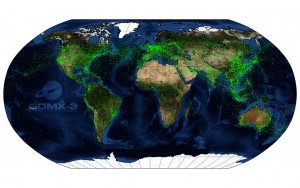
The GomX-3 CubeSat, sized 10x10x30 centimeters with an approximate mass of 3 kilograms, has picked up millions of signals that give flight information such as speed, position and altitude. (Credit: ESA/GomSpace)
The GomX-3 CubeSat, which was ejected from the International Space Station on Oct. 5, 2015, has been tracking aircraft in flight across Earth. Built for the European Space Agency (ESA) by GomSpace in Denmark, the CubeSat's distinctive helical antenna has detected millions of signals from aircraft.
This 3-unit GomX-3 is ESA's very first technology CubeSat to fly, explains Roger Walker, overseeing ESA's technology CubeSat effort. We were able to make it operational within only 96 hours of its release from the Space Station, with a wide variety of tests taking place during the following months.
GomX-3 was supported by ESA through its General Support Technology Programme, aimed at converting promising engineering concepts into spaceworthy products.

